Your smartwatch’s breathing data reveals critical health insights you can’t detect otherwise. It monitors sleep apnea with 75-96% accuracy, detecting breathing disruptions and irregular patterns during sleep. The PPG sensors track respiratory rates, oxygen saturation levels, and cardiovascular changes that may indicate infections or chronic conditions early. You’ll discover stress responses, sleep quality patterns, and fitness recovery data through continuous monitoring. Advanced algorithms flag irregularities across multiple nights, promoting proactive health management and early medical consultation when needed.
How Smartwatches Capture Your Breathing Patterns During Sleep
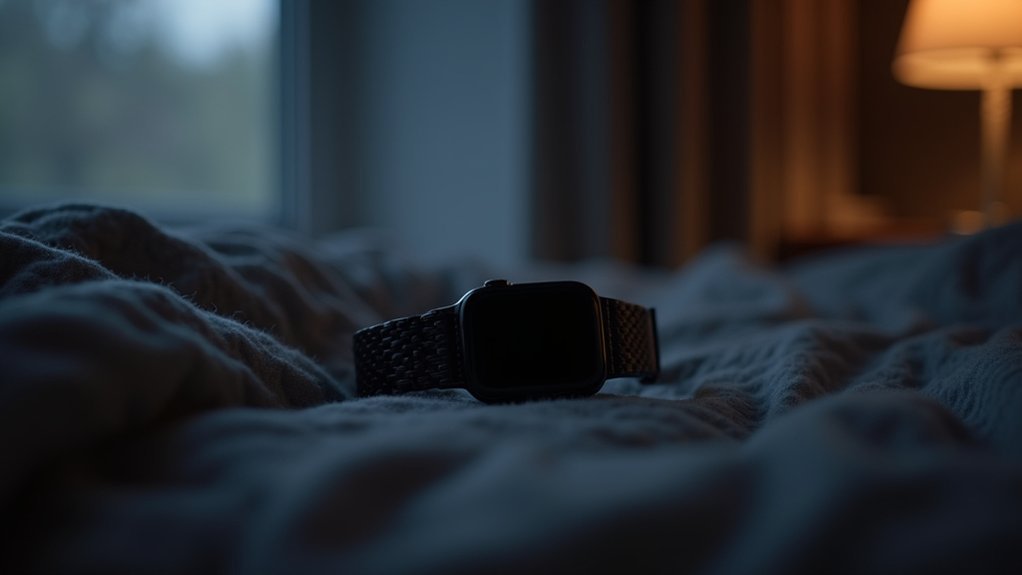
While you sleep, your smartwatch works continuously to monitor your breathing patterns using sophisticated built-in sensors that detect disruptions associated with sleep disorders like obstructive sleep apnea.
Your device analyzes these disruptions over extended periods—Apple Watch monitors for 30 days while Galaxy Watch tracks for 10 days—to identify concerning patterns.
Extended monitoring periods allow smartwatches to establish reliable baseline patterns, with Apple Watch tracking 30 days compared to Galaxy Watch’s 10-day analysis window.
You’ll need to wear your smartwatch for more than four hours nightly across multiple nights for effective monitoring. The sensors capture breathing irregularities that may indicate obstructive sleep apnea, providing data that’s been FDA-cleared for health monitoring credibility.
Your smartwatch doesn’t just track breathing—it simultaneously monitors heart rate, respiratory rate, and wrist temperature, creating thorough sleep health insights that help you understand potential sleep disorders requiring medical attention. These smartwatch alerts serve as an initial indication of potential sleep apnea, guiding users to seek medical help.
The Science Behind PPG Sensors and Respiratory Monitoring
Behind your smartwatch’s ability to track breathing lies photoplethysmography (PPG), an optical technique that measures blood volume changes in your microvascular bed using light transmission or reflection.
Your PPG signal contains both pulsatile components from your heartbeat and quasi-constant components influenced by respiratory activity.
When you breathe, respiratory frequencies between 0.15-0.60 Hz modulate the quasi-constant component, allowing algorithms to extract your breathing rate through signal processing.
These changes occur because respiration creates variability in your blood volume and vessel diameter, which the PPG sensor detects as signal modulation.
Advanced algorithms combine preprocessing, selective windowing, and modified Welch filtering to enhance accuracy.
They’re designed to remain robust against motion artifacts and low-quality data, ensuring reliable respiratory monitoring from your wrist-worn device. The technology achieves high accuracy with measurements showing correlations exceeding 0.96 compared to clinical-grade equipment.
Accuracy Levels of Wearable Breathing Measurements
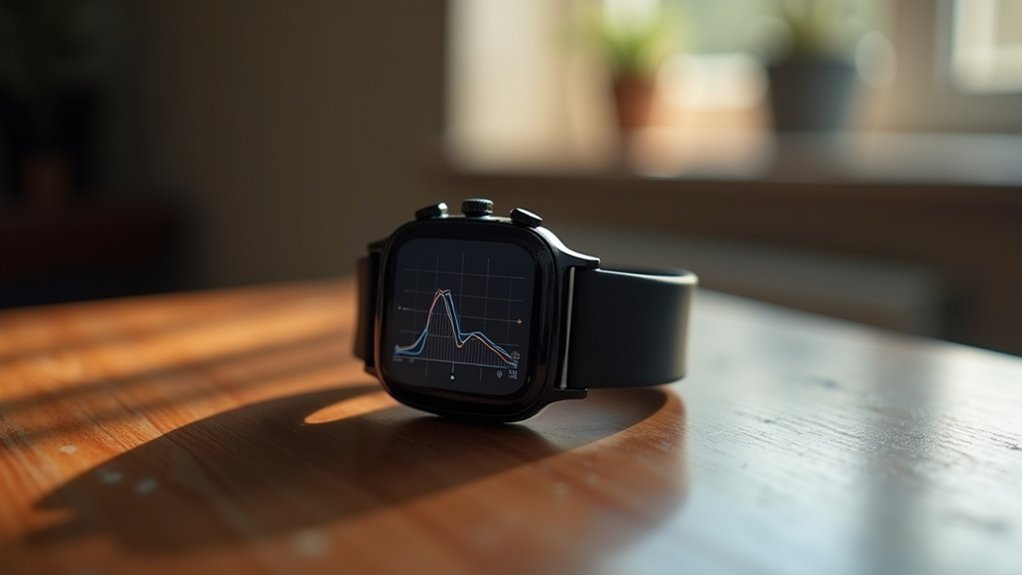
When you’re evaluating your smartwatch’s breathing measurements, you’ll want to understand how they stack up against clinical-grade equipment used in medical settings.
Your device’s accuracy can vary greatly depending on your health status and activity level, with performance metrics showing different reliability ranges across various real-world conditions.
You’ll find that while these wearables show promising results in controlled studies, their effectiveness in your daily life depends on factors like movement, ambient conditions, and any underlying respiratory conditions you might have. Research indicates that wearable devices typically show a mean absolute percentage error of approximately 15-16% when compared to laboratory-grade measurements, though this accuracy can improve in individuals with higher fitness levels.
Clinical Reference Comparison
Although smartwatches excel at measuring heart rate with impressive accuracy, their respiratory tracking capabilities don’t yet match clinical-grade standards.
When you compare your smartwatch’s breathing measurements to medical equipment, you’ll notice significant differences that affect clinical reliability.
Here’s how smartwatch breathing data compares to clinical references:
- Oxygen saturation monitoring – Your device overestimates SpO2 readings below 95% and underestimates levels above 95%, creating potential diagnostic concerns.
- Respiratory rate tracking – Smartwatches consistently underestimate your breathing rate, particularly during shallow breathing or pattern changes.
- PPG technology limitations – Your watch’s photoplethysmography requires advanced signal processing to achieve reasonable accuracy for respiratory measurements.
- Clinical validation gaps – Current devices lack sufficient clinical validation for reliable healthcare applications.
Sleep disorders significantly impact measurement accuracy, with studies showing that severe OSA reduces respiratory rate tracking precision to approximately 75-79% compared to over 90% accuracy in normal conditions.
Real-World Performance Metrics
Performance metrics reveal that wrist-worn devices achieve surprisingly strong correlations with standard breathing measurements, showing r-values between 0.679 and 0.942 depending on your specific device and the metric being tracked.
You’ll find resting condition errors typically stay under 10 bpm for heart rate, with similar small margins for respiration rate.
However, accuracy drops during exercise due to dynamic environment challenges. Your smartwatch may struggle detecting irregular or extreme breathing rates, especially very slow or fast patterns.
Averaging algorithms can mask true respiratory rate variability, showing moderate readings for prolonged periods. Most devices default to 12-20 breaths per minute ranges, sometimes missing extreme rates below 12 or above 20.
Overall performance remains reasonably accurate for routine monitoring when properly calibrated and fitted. Changes in breathing patterns may reflect your body’s stress response to various situations throughout the day.
Machine Learning Models That Decode Sleep Breathing Data
Since smartwatches continuously collect breathing patterns during sleep, researchers have developed sophisticated machine learning models to transform this raw data into meaningful health insights.
These algorithms can identify sleep-disordered breathing by analyzing your respiratory patterns alongside other physiological signals like heart rate variability.
Advanced models use multiple approaches to decode your sleep breathing data:
- Deep Learning Networks – LSTM algorithms excel at processing sequential breathing data, outperforming traditional classification methods in detecting sleep apnea events.
- Multi-Signal Integration – Models combine respiratory data with actigraphy and cardiac information for enhanced accuracy in sleep stage classification.
- Real-Time Detection – Algorithms identify specific apnea episodes during sleep cycles with fine-grained temporal resolution.
- Risk Assessment – Models evaluate breathing irregularities alongside demographic factors to predict sleep disorder severity.
The respiratory information particularly enhances detection of wake and REM sleep phases, making it a crucial component for improving sleep monitoring algorithms beyond traditional actigraphy alone.
Real-Time Detection of Sleep Apnea and Breathing Irregularities
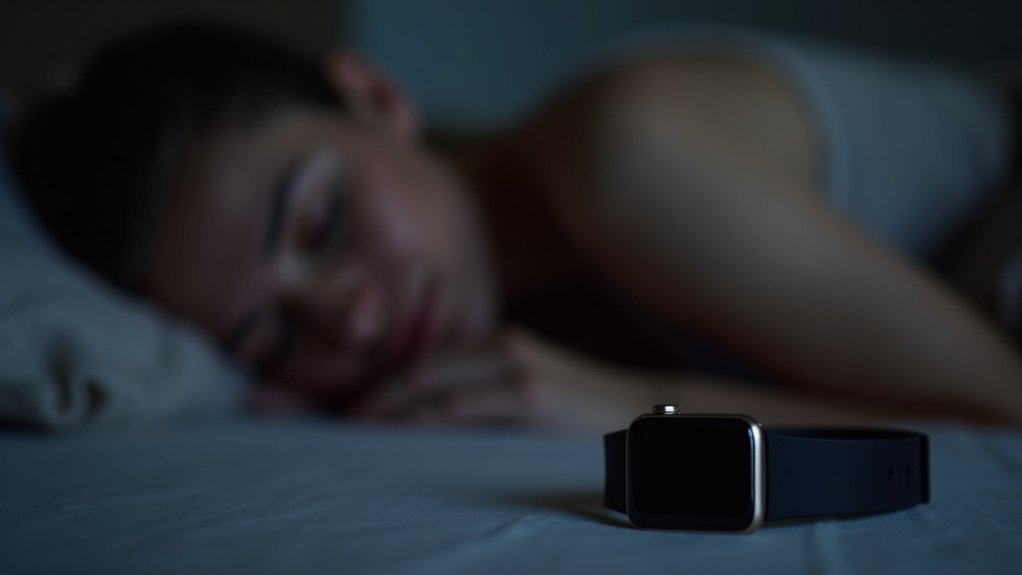
Your smartwatch can now spot sleep apnea events as they happen by analyzing your breathing patterns in real-time.
The device’s algorithms recognize irregular breathing sequences and predict when apnea episodes are likely to occur based on subtle changes in your respiratory rhythm.
You’ll receive immediate alerts when these breathing disruptions are detected, allowing you to understand your sleep quality patterns and seek medical evaluation when necessary. These devices achieve 75-96% accuracy in identifying users who later receive confirmed obstructive sleep apnea diagnoses from medical professionals.
Apnea Event Forecasting
Although sleep apnea affects millions of people worldwide, many cases remain undiagnosed due to the inconvenience and cost of traditional sleep studies. Your smartwatch’s apnea event forecasting capabilities change this by continuously monitoring your breathing patterns and predicting potential risks before they become serious health issues.
Your device calculates nightly breathing disturbance scores that reflect the frequency and duration of interrupted breaths during sleep.
Here’s how smartwatch forecasting works:
- Pattern Recognition – Monitors breathing for 30 days to identify consistent disturbance trends
- Risk Alerts – Triggers notifications when elevated disturbance values persist across multiple nights
- Real-Time Detection – Identifies apneic events as they occur during sleep
- Clinical Integration – Exports detailed data for healthcare provider assessment and treatment planning
The Apple Watch requires users to charge strategically since its 18-hour battery life necessitates planning to ensure overnight monitoring capability.
Irregular Pattern Recognition
When you sleep, your smartwatch’s triaxial accelerometers capture both your body’s movement and the subtle chest motions created by breathing. Advanced algorithms analyze this data alongside heart rate and blood oxygen saturation to detect breathing disturbances in real-time. Your device flags irregularities when they exceed preset thresholds across multiple nights, sending notifications about potential sleep apnea risks.
| Detection Capability | Accuracy Range |
|---|---|
| Sleep apnea risk alerts | 75-96% correlation |
| Moderate to severe OSA | Highest sensitivity |
| Real-time pattern analysis | Continuous monitoring |
| Clinical validation | Strong correlation |
This technology identifies breathing pauses, gasping, and irregular respiratory rates you might miss. While not providing definitive diagnosis, your smartwatch serves as an effective screening tool, promoting early medical consultation and establishing baseline patterns over extended periods. The feature is designed for users aged 22 and above who haven’t previously been diagnosed with sleep apnea, requiring at least two nights of measurement data to generate accurate results.
Motion Artifacts and Signal Processing Challenges
Motion artifacts represent one of the most significant obstacles you’ll encounter when analyzing respiratory data from smartwatches.
Physical activity corrupts photoplethysmogram (PPG) signals with spikes and high-frequency noise, while accelerometer and gyroscope data become contaminated by wrist movements that mask true breathing patterns.
Here are four key challenges you’ll face:
- Signal Distortion – Wrist movements create interference that mimics or obscures actual respiratory irregularities.
- Data Gaps – Non-wearing periods introduce missing data that can be mistaken for physiological changes.
- Free-Living Variability – Uncontrolled environments increase noise compared to clinical settings.
- Processing Complexity – You’ll need advanced techniques like Independent Component Analysis and deep learning models to separate genuine respiratory signals from motion artifacts.
These challenges directly impact measurement accuracy and clinical reliability. The low-frequency range containing respiratory information becomes particularly vulnerable to contamination from motion and environmental noise.
Clinical Validation Studies and Performance Metrics
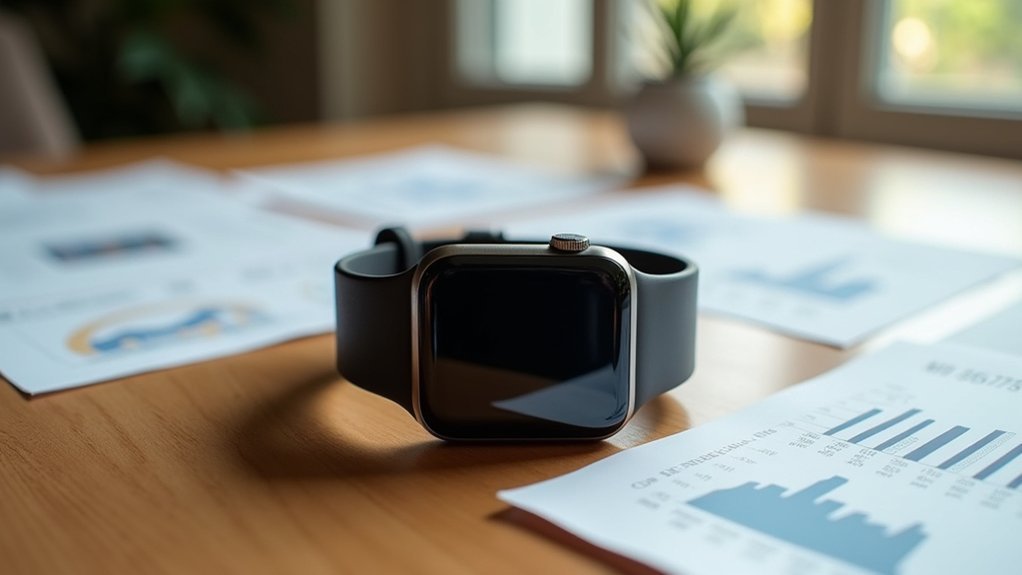
Before smartwatch breathing data can be trusted in healthcare settings, rigorous clinical validation studies must demonstrate that these consumer devices can match the accuracy of medical-grade equipment.
You’ll find these studies typically compare wearable respiratory monitors against capnography systems across respiratory rates from 4-40 breaths per minute in adults aged 18 and older.
The results are promising: correlation values range from 0.884 to 0.991, with bias under 0.1 breaths per minute in Bland-Altman analyses.
Smartwatch breathing monitors demonstrate exceptional accuracy with correlations exceeding 0.88 and minimal measurement bias against medical-grade equipment.
You’ll see 95% limits of agreement spanning ±1.7 to ±3.9 across studies, all achieving statistical significance (p < 0.001).
Advanced algorithms integrating heart rate variability, oxygen saturation, and temperature show 68.2% to 85.9% accuracy for detecting pulmonary infections, supporting wearables’ potential in clinical monitoring.
Clinical studies demonstrate that specialized wearable devices like AcuPebble achieve mean errors of 1.4 to 1.83 breaths per minute when validated against gold-standard capnography systems.
Health Insights From Continuous Respiratory Tracking
While clinical validation proves smartwatches can accurately measure breathing patterns, the real value emerges from continuous respiratory tracking that reveals health insights impossible to capture through sporadic clinical visits.
Your smartwatch doesn’t just count breaths—it creates a thorough health profile by integrating respiratory data with other essential signs. This continuous monitoring detects subtle changes that might signal developing health issues before you’d notice symptoms.
Here’s what your breathing data reveals:
- Early infection detection – Respiratory rate changes often precede fever and other COVID-19 or illness symptoms.
- Sleep disorder identification – Irregular breathing patterns combined with SpO2 drops indicate sleep apnea.
- Fitness recovery tracking – Elevated resting respiratory rates signal incomplete recovery from exercise or illness.
- Chronic condition management – Breathing pattern deviations help monitor asthma, COPD, and cardiovascular conditions.
Most wearables track respiratory rate primarily during sleep when movements don’t interfere with heart rhythm analysis used to measure breathing patterns.
Future Developments in Wearable Sleep Breathing Technology
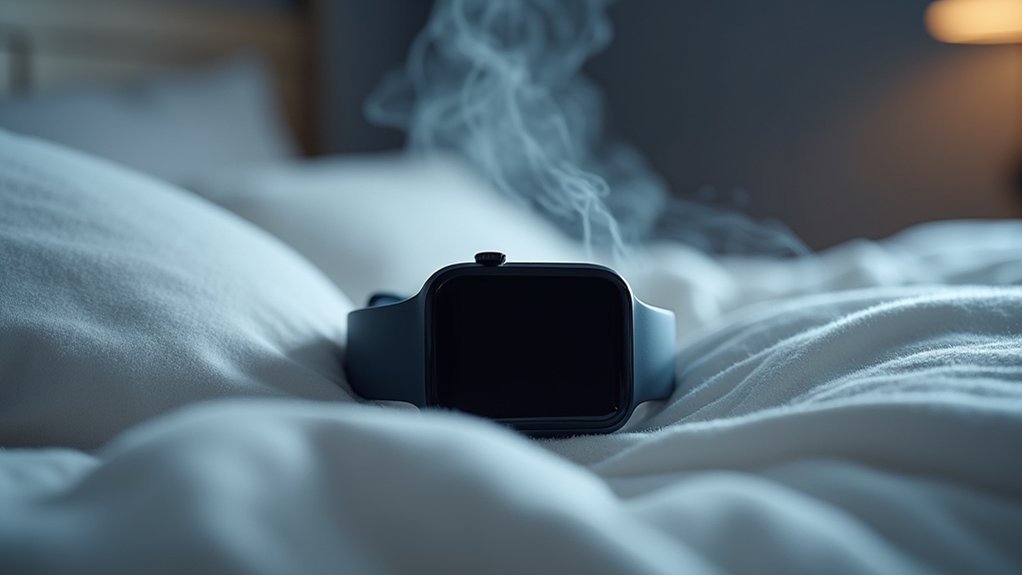
As artificial intelligence transforms healthcare wearables, your sleep breathing monitoring is approaching a revolutionary leap forward.
You’ll soon experience AI-powered devices that detect breathing disorders like sleep apnea with unprecedented precision, replacing costly polysomnography with comfortable wearable diagnostics. Real-time data processing will provide immediate feedback, improving your compliance and outcomes while algorithms continuously evolve to differentiate breathing irregularities and their severity.
Future wearables will integrate telemedicine capabilities for remote monitoring and personalized treatment plans. These devices will establish baseline values for your normal breathing patterns, enabling the detection of even subtle changes that could indicate developing respiratory issues.
You’ll benefit from sonic-pulse technology that targets deep sleep stages, using controlled sound to reduce breathing disruptions through airway relaxation. Smart mattresses will automatically adjust your position to maintain ideal airway alignment, while biofeedback mechanisms stabilize respiratory patterns during vulnerable sleep phases, creating thorough breathing optimization platforms.
Frequently Asked Questions
Can Smartwatch Breathing Data Help Detect COVID-19 or Other Respiratory Infections?
Your smartwatch can detect COVID-19 and respiratory infections by monitoring elevated breathing rates during sleep. It identifies roughly 80% of cases by symptom day three, enabling early isolation and reduced transmission.
How Long Does Smartwatch Battery Last When Continuously Monitoring Breathing Patterns?
You’ll typically get 1-2 days of battery life when continuously monitoring breathing patterns on full-featured smartwatches, though hybrid models can extend this to several weeks with optimized power management.
Is Smartwatch Breathing Data Accurate Enough to Replace Medical Sleep Studies?
You can’t replace medical sleep studies with smartwatch breathing data alone. While devices show promising accuracy for screening sleep apnea, they lack the precision needed for definitive clinical diagnosis.
Can Breathing Data From Smartwatches Be Shared With Doctors or Insurance?
You can share your smartwatch breathing data with doctors and insurance companies, but you’ll need to provide explicit consent and guarantee compliance with privacy regulations like HIPAA or GDPR.
Do Smartwatches Work for People With Pacemakers or Other Medical Devices?
You can wear smartwatches with pacemakers, but you’ll need to maintain safe distance and follow guidelines. Consult your healthcare provider first, as certain features may cause electromagnetic interference with your device.
In Summary
You’ll discover that your smartwatch’s breathing data offers unprecedented insights into your sleep quality and respiratory health. While current accuracy levels show promise, you shouldn’t rely solely on these devices for medical diagnoses. As machine learning algorithms improve and clinical validation studies expand, you’ll see more reliable detection of sleep apnea and breathing disorders. Your continuous respiratory tracking data will become increasingly valuable for personalized health monitoring and early intervention strategies.

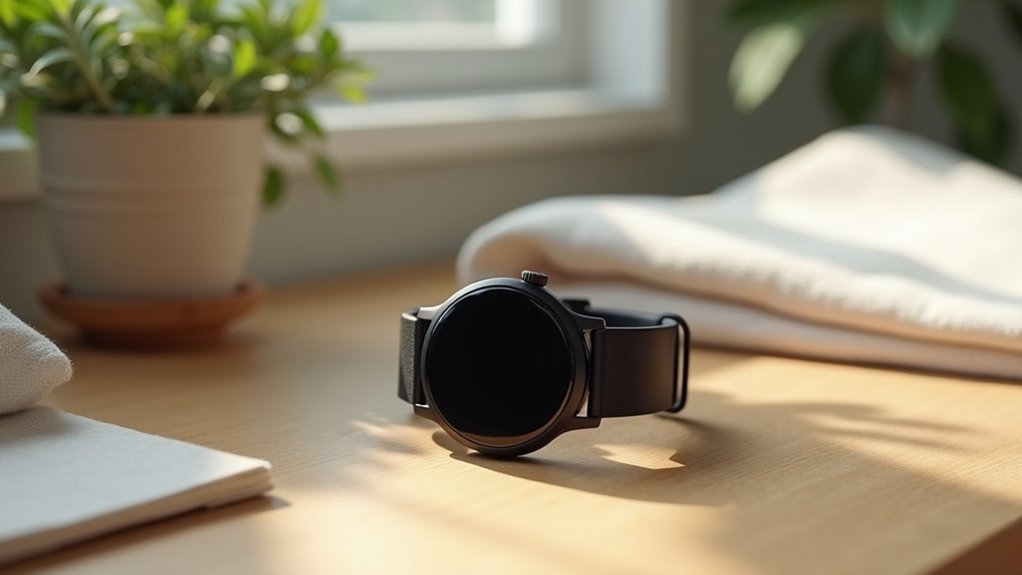
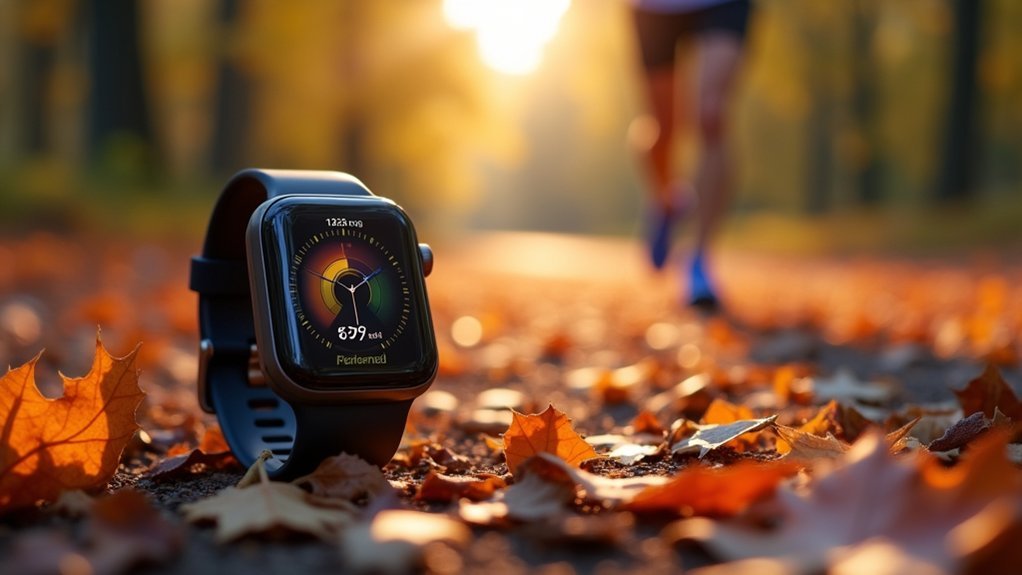
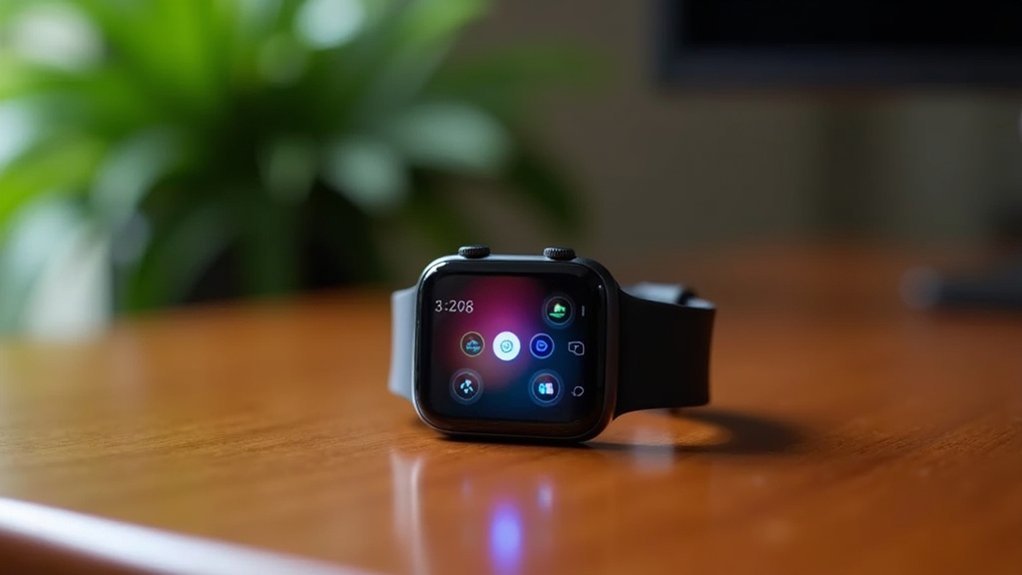
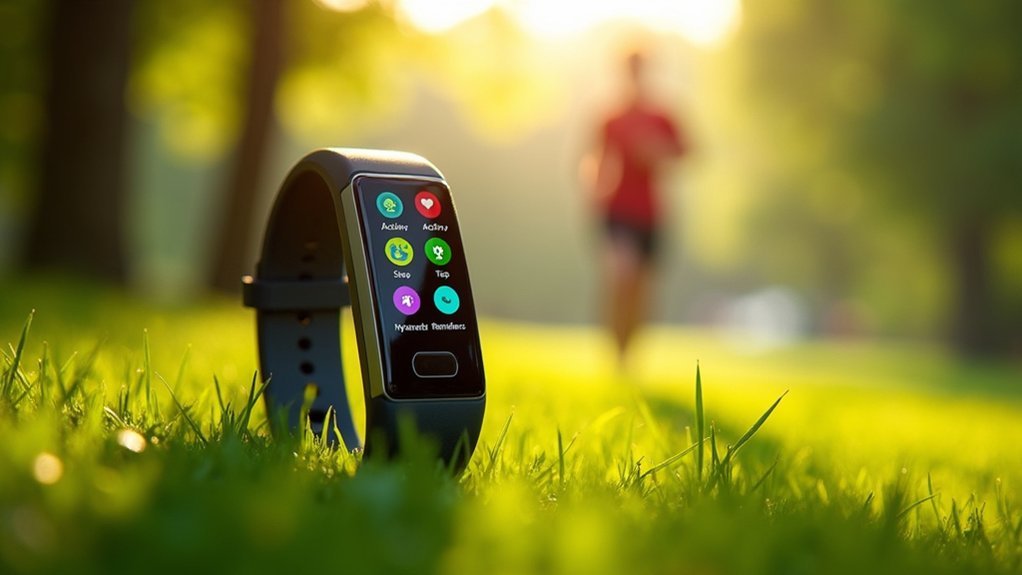
Leave a Reply